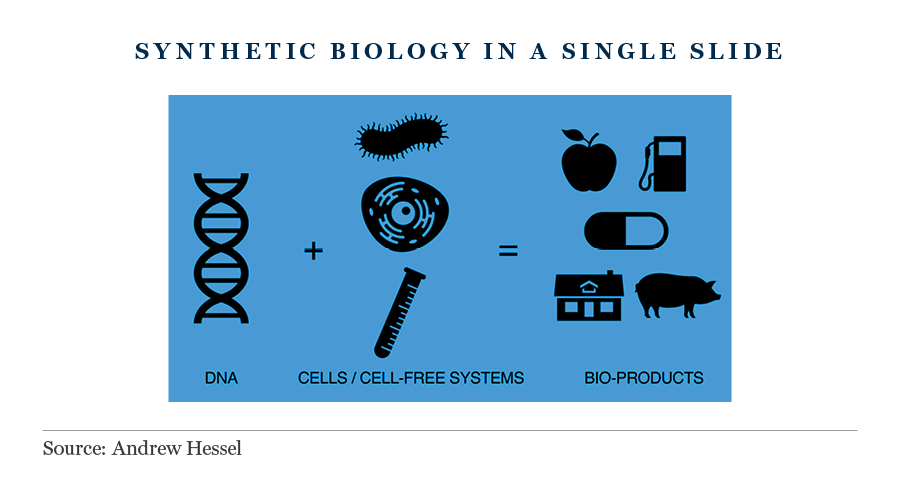How will synthetic biology solve or mitigate some of the most critical problems facing humanity, from food scarcity, infertility and species extinction to climate change, chronic disease and viral outbreaks? As previously unimaginable innovations loom on the horizon, we should all understand how synthetic biology is poised to transform business, government and society. At Walter Scott’s 2023 Research Conference, academic, author and serial entrepreneur Andrew Hessel outlined the importance of synthetic biology today. He also shared his thoughts on what might come next and the challenges that should not be ignored.
Synthetic biology sits at the intersection of three fields: biology, computation and engineering. I define it as a set of tools and processes that make biology easier to design, build and engineer.
All life is made of cells. Cells individually are too small to see with the naked eye but they are the most sophisticated machines known today. The smallest ones – bacteria – are billions of years old but share the same architecture as our cells and because cells are so universal, and they all share the same machinery, so all life on earth reduces to code. And like computer software, code can be edited, read and be written, and this is the heart of synthetic biology.
The process starts with a chunk of DNA that contains instructions for something you want to make. You put it into a cell, it could be a microbe or it could be a more complex cell, and it will take over the machinery in those cells to produce your biological product. The opportunity for synthetic biology is to replace natural resources with engineered biological resources, allowing our economies to keep growing and keep scaling in a sustainable way.
Plotting the Developments in Synthetic Biology
Synthetic biology began about 50 years ago when Genentech, a start-up in the Bay area, used genetic engineering to produce human insulin to treat diabetes. That was the birth of the biotech industry. Since then biology has become a digital technology. It began in 1990 with the launch of the human genome project, the biggest scientific project in the world. It cost $3 billion, took 13 years to complete and opened the doors to genetics because it digitised genetic engineering. It came in under budget, and on time. That’s not just because of brilliant management, but because the technology was changing so fast, and it’s continued to change.
Since the genome project wrapped up, sequencing technology has continued to accelerate at up to five times Moore’s law. It is one of the fastest changing technologies ever. Today companies like Illumina sell machines that will sequence multiple human genomes in a day for an all-in cost of around $200. Roswell commercialised the first molecular electronic chip. This is essentially the fusion of semiconductor technologies and biotechnologies on a single chip. You can attach molecules to defined elements on this chip and it has been turned into a sequencer. These chips cost $1 to manufacture.

But whilst these are important innovations in reading code, that’s like going to a library and just looking at the books that are already there. Writing genetic code is where it gets creative. In the early 2000s, Drew Endy and Tom at MIT started to take genetic code and modularise it so it snapped together easily and quickly. They were working with physical DNA. Today it’s all done electronically and there are word processors for the DNA molecule that allow you to do search and replace or move blocks around.
As to what comes next. 3D printers for the DNA molecule are emerging and that will power the next phase. These printers aren’t very good, yet. They can’t make super long strands of DNA, but they make enough that you can start to build things like proteins.
Applications
The mRNA vaccines that tackled Covid were the most important application of synthetic biology we have experienced in recent years. They could not have been produced at that scale and pace without synthetic biology. It was really the biggest up-shift in vaccine development that the world has ever seen.
The vaccines are essentially just a programme that uses human cells and turns the human into a manufacturing plant. You literally just inject into your arm and you become the factory. And we’re just getting started with this. Now that we’ve unlocked that particular door there is big potential, particularly in cancer therapies.
But food is probably the biggest and fastest growing application of synthetic biology. It’s relatively lightly regulated, and it’s extremely creative. We’re seeing engineered fish, pork, chicken, and beef that are all made sustainably without harming animals. We’re making vegetables and fruits that now are more fortified, more nutritious, have better shelf life and better pest resistance.
Bio-manufacturing enables us to make products at scale with minimal environmental impact. We’ve started to invest heavily in how to bio-manufacture. We source a lot of collagen and gelatin for cosmetics and other products. Today we can bio-manufacture instead of tearing the hide off a cow, tanning it and dying so we can have a couch in our living room. We can now make very similar products using protein source from plants or mushrooms and do it at scale. The sky’s the limit with what we can make. As long as biological material is part of the process, we can programme it.
Trends to Follow
Artificial intelligence tools are going to become massive in synthetic biology because large language models can work with the language of DNA or proteins, in a way that humans can’t.
We’re quickly moving into a world where we can design living cells from scratch. At the moment, it’s expensive to do this work, but when we can synthesise the E. coli genome for a few hundred dollars, the organism becomes ‘print on demand’ and you get full control over its function. And that’s going to be the biggest shift in cell biology pretty much ever.
Artificial intelligence tools are going to become massive in synthetic biology because large language models can work with the language of DNA or proteins, in a way that humans can’t
Stories of the future
We’re seeing big advances in areas like food, agriculture and pharmaceutical development. From companies making molecular spirits that share the same structure as 50-year-old cask-aged whisky, to working with enzymes to degrade plastic bottles in 24 hours. We’re also banking some of the creatures that we’ve threatened with our success by building frozen zoos where we capture cells and tissues and genetics. We’ve been using biotechnology to help real human reproduction for a long time. Today, we can pluck a cell out of an embryo and do full genome sequencing.
Challenges
There are so many opportunities with synthetic biology. In the last few years, we’ve all learned a lesson about our lack of biological preparedness for the Covid pandemic. The pandemic cost trillions of dollars, millions of lives and it stunted our societies. Going forward, we have to be able to fight epidemic disease because some of the easiest things to make with synthetic biology have the smallest amount of code.
Engineered pandemics are also a real threat that no one’s taking seriously yet. We’ve seen this dynamic before in computers. The first computers had no firewalls, no protection. Then we got antivirus software, and today cybersecurity is a $200 billion industry.
We need to apply that thinking in life science if we’re going to build a thriving ecosystem of synthetic biology. And if we ignore this and just work on the applications of the day, it’s going to get stunted. We have a choice.
This is an edited transcript of a speech given by Andrew Hessel at Walter Scott’s Research Conference on 10 May. A synopsis with summaries of all the other sessions that took place over two and a half days in Edinburgh can be found here.
Further Insights
White Paper: Synthetic Biology – Long-Term Opportunities in the Bioeconomy
Podcast: An Introduction to Synthetic Biology
Stock Story: Lonza
Important Information
The statements and opinions expressed during Walter Scott’s Research Conference and in all post conference communications, including this article, are those of the guest speaker, be that an external speaker or employee of Walter Scott, at the date stated and do not necessarily represent the view of Walter Scott, The Bank of New York Mellon Corporation, BNY Mellon Investment Management or any of their respective affiliates.
This article is provided for general information only and should not be construed as investment advice or a recommendation. This information does not represent and must not be construed as an offer or a solicitation of an offer to buy or sell securities, commodities and/or any other financial instruments or products. This document may not be used for the purpose of an offer or solicitation in any jurisdiction or in any circumstances in which such an offer or solicitation is unlawful or not authorised.
Stock Examples
Any information provided in this article relating to stock examples should not be considered a recommendation to buy or sell any particular security. Any examples discussed are given in the context of the theme being explored.

